Mushrooms
Media
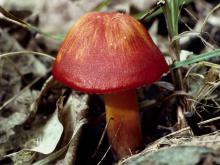
Species Types
Scientific Name
Hygrocybe coccinea (Hygrophorous coccineus)
Description
The scarlet waxy cap has a scarlet, moist cap, with a stem colored like the cap (or a little more orange). It grows on the ground in mixed woods.
Media
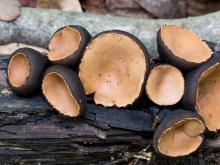
Species Types
Scientific Name
Galiella rufa (formerly Bulgaria rufa)
Description
The hairy rubber cup has a reddish to brownish inner surface; the outside is blackish brown and hairy. It grows in clusters on dead deciduous wood.
Media

Species Types
Scientific Name
Sarcoscypha occidentalis
Description
The stalked scarlet cup is, indeed, a tiny red cup on a tiny white stalk. It grows scattered on fallen wet sticks and branches in damp deciduous woods.
Media
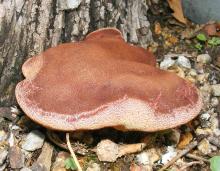
Species Types
Scientific Name
Fistulina hepatica
Description
The beefsteak polypore is a thick, semicircular, reddish or rusty, gelatinous bracket with a pinkish yellow underside. It grows at the base of living oaks and on stumps.
Media

Species Types
Scientific Name
Ganoderma sessile (formerly G. lucidum)
Description
The ling chih is a hard, usually flat, zoned bracket fungus with a reddish brown, shiny top. It grows at the base of living and dead deciduous trees, and also around stumps.
Media
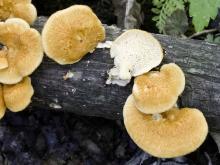
Species Types
Scientific Name
Polyporus alveolaris (formerly Favolus alveolaris)
Description
This polypore is an orange to tan, fan-shaped bracket that is scaly on top; the underside has rows of white, six-sided, radially arranged pores. It grows singly or in groups on dead branches of deciduous trees.
Media

Species Types
Scientific Name
Laetiporus sulphureus
Description
Sulfur-colored chicken of the woods is an edible fungus with layered, fan-shaped, fleshy caps that are orange on top and sulfur yellow below. It grows in overlapping clusters on stumps, trunks, and logs of dead or dying deciduous trees, and on living trees and buried roots.
Media

Species Types
Scientific Name
Phlebia incarnata (formerly Merulius incarnatus)
Description
The coral-pink merulius is a small, semicircular bracket fungus that is pinkish to coral to cream-colored, wrinkled, and veined beneath. It grows on dead logs and stumps of deciduous trees.
Media
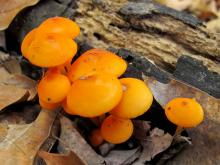
Species Types
Scientific Name
Mycena leaiana
Description
The orange mycena is a small, sticky, bell-shaped, orange mushroom. It grows in dense clusters on deciduous wood.
Media
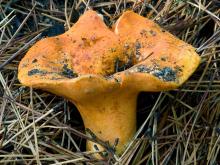
Species Types
Scientific Name
Hypomyces lactifluorum
Description
In a lobster mushroom, the cap, gills, and stalk of a host mushroom are covered by a finely bumpy, vivid orange to orange-red layer of mold. The gills of the host mushroom can be entirely obscured by the parasite.
See Also
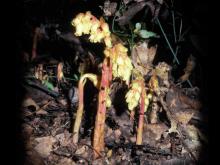

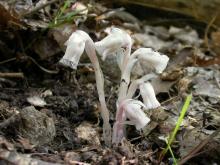
Media

Species Types
Scientific Name
Monotropa hypopitys
Description
Pinesap is a plant that puts the "wild" in wildflower! It lacks chlorophyll, so its roots connect to fungi underground and absorb nutrients from the fungi.
Media

Species Types
Scientific Name
Cladophora, Pithophora, and Spirogyra spp., and others
Description
Filamentous green algae forms green, cottony masses that are free-floating or attached to rocks, debris, or other plants.
Media

Species Types
Scientific Name
Monotropa uniflora
Description
Indian pipe lacks chlorophyll, so it is white, not green. Below ground, its roots join with fungi that connect to tree roots. This plant, then, takes nourishment indirectly from the trees.
About Mushrooms in Missouri
Mushrooms are a lot like plants, but they lack chlorophyll and have to take nutrients from other materials. Mushrooms are neither plants nor animals. They are in a different kingdom — the fungi. Fungi include the familiar mushroom-forming species, plus the yeasts, molds, smuts, and rusts.
Always be cautious when eating edible mushrooms. Be absolutely sure of the ID, and only eat a small amount the first time you try it to avoid a reaction..





















